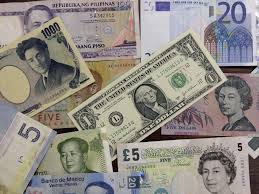Currencies swap hands every second, and here is a look at some of the key (and often surprising, facts) about exchange rates. For a similar list about GDP, click here. For a list on inflation, click here.
- The floating exchange rate system.
The current system of international exchange rate is what is known as a floating exchange rate. Each country’s currency is not determined by a fixed rate to each other; but rather, they currency is set by the Foreign-Exchange market (Forex), which entails supplies and demands for that particular currency. Therefore, the currency can change freely and often by quite a bit, sometimes requiring central bank intervention to help maintain the currency’s values.
- The US dollar’s premier standing.
The US dollar is used in around 80% of international trade and it forms over 60% of the foreign exchange reserves currencies in the world. The dollar is used extensively to settle international trade and forms a large part of the foreign currency holdings in the world, which allows central banks to purchase the domestic currencies, sometimes to maintain a certain exchange rate. The largest holder of foreign exchange reserves holders are China and Japan, which holds around 4 trillion and 1.3 trillion respectively, of which a majority is held in US dollars.
- Currencies: Hard and Soft.
Not all currencies are valued equally as a store of value, and economists distinguish between hard and soft currencies. The US dollar, Euro, and Swiss Francs are generally considered to be among the top 3 hard currencies in the world, and the currency that people would move their money into in the face of economic and political uncertainty. In comparison, soft currencies are generally viewed as unreliable and fluctuates greatly in the foreign exchange markets. When the Eurozone debt crisis hits, European countries moved their currencies toward Swiss Francs and US dollars, therefore eroding the power of the Euro slightly as a safe-haven currency.
- Foreign exchange markets are among the most unregulated markets in the world and operates non-stop.
Internationally, there are few regulations on foreign exchanges, and each day, many traders (or speculators rather) enter and exit the foreign exchange market. Insider trading is not regulated on the Forex exchanges. Traders trade on any piece of information that they think is relevant and can move the market. The market operates non-stop and depending on the location (New York, London, Tokyo, etc), someone is always awake ready to do work.
- Foreign Exchange markets are enormous, and diverse.
Over 4 trillion dollars are exchanged on the foreign exchange markets each day. Profits to be made on Forex is actually pretty low, therefore the trades are done through borrowing on margins. Leverage is used to enhance profits and loss, with respect to the size of the account. Currencies are traded in pairs, and over 100 currencies are traded on exchanges. However, there are four major currency pairs, which accounts for most of the volume traded:
The British Pound and US Dollar (GBP/USD)
The Euro and US Dollar (EUR/USD)
The US Dollar and Japanese Yen (USD/JPY)
The US Dollar and Swiss Franc (USD/CHF)
The US dollar is the most traded as a part of currency pairs, accounting for 87% of daily shares (out of 200% possible since it’s traded in pairs.)
Related Articles:





